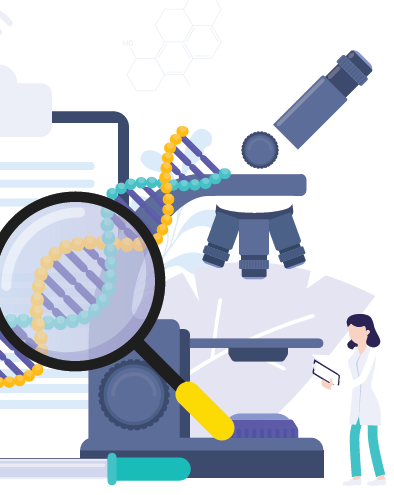
Since the completion of the Human Genome Project in 2003, there has been an explosion of knowledge about how our individual genetics influence our health. Two decades later, genetic testing has become a regular part of medical care and is widely advertised on social media platforms. With a couple of clicks, you can order testing to find out your ancestry, your salty versus sweet preference, and whether you are predisposed to cancer.
Direct-to-consumer genetic testing, or “at-home tests,” are genetic tests marketed and sold directly to individuals to provide information about their genetic sequences.1 Depending on the particular test, the ordering and return of results may or may not involve a healthcare professional. This form of genetic testing firmly places control in the hands of the individual being tested. While at-home testing provides better access to tests, it also puts the burden of test choice, interpretation, and follow-up on the consumer/individual. Here, I will present information to help you navigate this genetic testing landscape and decide if, when, and what testing fits your needs.
At-Home Testing Versus Traditional Genetic Testing
At-home testing has several advantages in comparison with the genetic testing provided through your healthcare provider. The first advantage is convenience; it involves less time since there are no required appointments or travel. At-home testing is typically performed via a saliva collection kit that is sent to your home. When incorporating costs, such as travel, co-pays, and time off, an at-home test may be less expensive than traditional genetic testing despite the fact that it is not covered by health insurance. Finally, the results of this testing are provided directly to you as soon as results are available, putting control of your genetic information in your hands.
However, at-home testing has several limitations as well. First, companies can offer testing for traits or conditions that do not have clinical guidelines or utility. For example, results from an at-home test might report your estimated risk for melanoma based on the presence of common genetic variants associated with increased risk. If you do not have melanoma but are identified as being at an increased risk by an at-home test, there are no guidelines that direct your next steps. Studies are ongoing as to the utility of these genetic risk scores,2 but no recommendations have been adopted yet.
Second, at-home tests are designed to look at a predetermined set of common genetic changes. In the realm of cancer genetic testing, the at-home test options often analyze the most common genetic changes associated with cancer. For example, BRCA1 and BRCA2 genes are the 2 most common genes associated with ovarian cancer running in families. For this reason, many at-home test companies offer analysis of these genes. However, individuals with genetic changes in the BRIP1, RAD51C, and RAD51D genes also have significant risks for ovarian cancer,3 but these genes are rarely included. Due to the limited scope of this testing, at-home tests cannot be used to rule out hereditary cancer conditions. People with a strong personal and family history of cancer should still consider traditional genetic testing.
Finally, any clinically significant at-home test results must be confirmed by a clinical test before any medical decisions can be made. Also, clinical testing laboratories are required to meet certain quality and regulatory standards that at-home test laboratories may or may not meet. Confirmatory testing may include additional costs.
Key Points
- At-home genetic testing can be a convenient and easy way to learn about your risk for certain health conditions
- Most at-home tests for cancer look only for the most common genetic causes of cancer. Individuals with strong personal and family histories of cancer may want to consider more comprehensive clinical testing
- When choosing a genetic test, pay attention to how and what a particular test does to make sure you choose a test that meets your needs
- Share your genetic test results with your provider, even if the results are negative.
Insurance Implications
Can Results From an At-Home Genetic Test Affect My Insurance Eligibility?
The Genetic Information Nondiscrimination Act of 2008 protects individuals from genetic discrimination by employers and health insurance.4 A health insurance company cannot require or use your genetic information to make decisions on coverage, premiums, or benefits. Employers (with the exception of the United States Armed Forces) cannot use genetic information to make hiring, firing, or promotion decisions.4
However, this law does not extend to other types of insurance, such as life insurance, long-term care insurance, or long-term disability insurance. For these policies, insurance companies can ask about and consider genetic testing results when deciding whether to cover you or what your premiums will be.
Selecting An At-Home Test
Time to pick a test! The first question when thinking about pursuing a genetic test should be “Why am I doing this?” Individuals use at-home genetic tests for many reasons—from just plain curiosity to specific concerns. Maybe the primary reason for testing is an interest in ancestry, and the possible health data are just a side benefit. Or maybe you wonder about a specific health condition running in your family, like breast cancer. Determining your main objective will assist in determining which test will be most helpful.
Once you determine why you are pursuing testing, you can look at the available tests for one that meets your needs. If you are pursuing genetic testing for a health-related reason, pay attention to exactly what information you will get from any particular test. Are the conditions you are interested in assessed by that test? How many genes or genetic changes related to the condition you are interested in are analyzed? Find a test that satisfies your needs.

Read the Fine Print
When choosing a test, it pays to read the description closely. Some at-home tests are comprehensive, performing testing with next-generation sequencing techniques just like or similar to clinical testing ordered by a healthcare professional. Other laboratories provide genotyping, which looks only at select common mutations within the gene of interest.1 If you do not suspect a hereditary cancer condition, then genotyping may be adequate. However, genotyping has the potential to miss an uncommon genetic cause for cancer risk.
In addition, these “common” mutations may only be commonly found in certain groups. For example, several at-home genetic test companies offer testing for 3 mutations in the BRCA1 and BRCA2 genes associated with increased risks for breast, ovarian, pancreatic, and prostate cancer. One in 40 individuals of Ashkenazi Jewish ancestry carries 1 of these 3 mutations.5 Individuals of Ashkenazi Jewish descent may be reassured by a test that rules out the presence of these mutations. However, if you are of Asian or African descent, these particular mutations are unlikely to be present, and a negative result may be falsely reassuring.
Think About Your Posttest Plans
As you plan your test, look at how results will be provided and what resources will be available to you. Most at-home test laboratories offer materials including summaries of medical guidelines and videos reviewing results for individuals who have positive findings on their tests. Several laboratories even offer a telephone or virtual results session with a genetic counselor. These resources can be very beneficial following a positive result, filling the time and information gap between getting your results and being able to speak with your healthcare provider.
Consider sharing your genetic test results with your provider regardless of the findings. If you are found to have a disease-causing gene change, it is important to share this information with your provider. Your provider may refer you to local specialists to confirm the genetic test results and develop a plan for future screenings. Even negative results are important to share, as they also provide valuable information.
Be aware that a negative test does not mean you do not have an increased risk for the cancers in your family. Approximately 10% of colon cancers are caused by hereditary cancer conditions. Another 20% of colon cancers occur in individuals with at least 1 family member with colon cancer but no genetic explanation. This phenomenon is called familial clustering and is likely due to a combination of genes and environmental factors shared by family members. For this reason, the National Comprehensive Cancer Network recommends that individuals with a parent, sibling, or child with colon cancer begin colonoscopy at age 40 years and have repeat colonoscopies every 5 years.6
The phenomenon of familial clustering occurs in other cancers as well. Depending on your family history of cancer, increased cancer screenings may be recommended, regardless of genetic test results. Sharing results and family history information can allow you and your healthcare team to figure out how best to care for you.
Final Thoughts
At-home genetic testing has increased access to genetic information, providing convenience and control to consumers. However, with these benefits come challenges, including limitations in testing scope, potential for misunderstanding risks, and the need for confirmatory clinical testing. Careful consideration of your goals and the specifics of these tests is critical for choosing the most useful test for you.
Importantly, the journey does not end with receiving the results. Sharing results with your healthcare provider and accessing available resources are key to garnering the most benefit from an at-home genetic test. In this dynamic landscape of personal genomics, stay informed and navigate wisely.
References
- National Human Genome Research Institute. Direct-to-Consumer Genetic Testing FAQ. www.genome.gov/For-Health-Professionals/Provider-Genomics-Education-Resources/Healthcare-Provider-Direct-to-Consumer-Genetic-Testing-FAQ. Updated March 30, 2022. Accessed May 18, 2023.
- Roberts M, Asgari MM, Toland AE. Genome-wide association studies and polygenic risk scores for skin cancer: clinically useful yet? Br J Dermatol. 2019;181:1146-1155.
- National Comprehensive Cancer Network. NCCN Clinical Practice Guidelines in Oncology (NCCN Guidelines). Genetic/Familial High-Risk Assessment: Breast, Ovarian, and Pancreatic. Version 3.2023. February 13, 2023.
- National Human Genome Research Institute. Genetic Discrimination. www.genome.gov/about-genomics/policy-issues/Genetic-Discrimination. Updated January 6, 2022. Accessed May 18, 2023.
- Centers for Disease Control and Prevention. Jewish Women and BRCA Gene Mutations. www.cdc.gov/cancer/breast/young_women/bringyourbrave/hereditary_breast_cancer/jewish_women_brca.htm. Updated March 21, 2023. Accessed May 18, 2023.
- National Comprehensive Cancer Network. NCCN Clinical Practice Guidelines in Oncology (NCCN Guidelines). Colorectal Cancer Screening. Version 1.2023. May 17, 2023.
About the Author
Megan Mortenson, MS, CGC, is a Cancer Genetic Counselor with over 16 years of experience. She works at WakeMed Cancer Care in Raleigh, NC.
More on Genetics
Hereditary Breast and Ovarian Cancer Syndrome: BRCA Mutations and the Impact on Families














